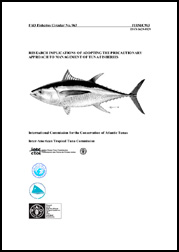
FAO Fisheries Circular No. 963
FIRM/C963
ISSN 0429-9329
International Commission for the Conservation of Atlantic Tunas
Inter-American Tropical Tuna Commission

International Commission for the Conservation of Atlantic Tunas
Inter-American Tropical Tuna Commission
FOOD AND AGRICULTURE ORGANIZATION OF THE UNITED NATIONS
Rome, 2001
|
Copies of FAO publications can be requested from: |
|
The designations employed and the presentation of material in this information product do not imply the expression of any opinion whatsoever on the part of the Food and Agriculture Organization of the United Nations concerning the legal status of any country, territory, city or area or of its authorities, or concerning the delimitation of its frontiers or boundaries. |
All rights reserved. Reproduction and dissemination of material in this information product for educational or other non-commercial purposes are authorized without any prior written permission from the copyright holders provided the source is fully acknowledged. Reproduction of material in this information product for resale or other commercial purposes is prohibited without written permission of the copyright holders. Applications for such permission should be addressed to the Chief, Publishing and Multimedia Service, Information Division, FAO, Viale delle Terme di Caracalla, 00100 Rome, Italy or by e-mail to [email protected]
© FAO 2001
1.1 Background
1.2 Proposed research or actions
1.3 Uncertainty expected in results of tuna research
1.4 Review of tuna biology1.4.1 Characteristics of tropical and temperate tunas
1.4.2 Stock structure and mixing rates
1.4.3 Spatial distribution and movements
1.4.4 Biological parameters1.5.1 Mandates for criteria and/or management objectives for the CCSBT, IATTC, ICCAT, IOTC and SPC
1.5.2 Review of Precautionary Approaches in other bodies with respect to research implications
1.5.3 Definitions of concepts
2 IMPLICATIONS FOR STOCK ASSESSMENT OF TUNAS AND ASSOCIATED SPECIES
2.1.1 Control rules
2.1.2 Recovery plans
2.1.3 Communication
2.1.4 Research links2.2.1 Characteristics of tunas and tuna-like fishes as they relate to stock assessment models
2.2.2 Model types
2.2.3 Measures of abundance
2.2.4 Stock-recruitment relationships and projections
2.2.5 Empirical methods2.3 Ecological and environmental issues in stock assessments
2.3.1 By-catches and stock assessment
2.3.2 Environmental issues in stock assessments2.4.1 Sources of uncertainty
2.4.2 Data required to quantify and reduce uncertainty
2.4.3 Quantification of uncertainty2.5 Alternative sources of information
2.5.1 Adaptive learning through probing
2.5.2 Industry participation
3 IMPLICATIONS FOR BIOLOGICAL AND ENVIRONMENTAL RESEARCH
3.1 Introduction
3.2 Pending problems and how they might be solved3.2.1 Catch at age
3.2.2 Age-specific natural mortality
3.2.3 Variability in biological parameters in accordance with time and density
3.2.4 Stock structure, spatial heterogeneity and mixing rates
3.2.5 Genetic diversity3.3 Impacts of environmental variability
3.3.1 Inter-annual variability
3.3.2 Decadal variability
3.3.3 Long-term changes
3.3.4 Different time scales and similar mechanisms3.4 Catches of target and by-catch species by fisheries for tunas and tuna-like fishes
3.4.1 Definitions
3.4.2 Available data
3.4.3 Vulnerability
3.4.4 Challenge of developing indices of relative abundance for vulnerable species
3.4.5 Catches of target and by-catch species by major gear types
3.4.6 General recommendations on the problem of by-catches in tuna fisheries3.5 Ecosystems and tuna fisheries: the Precautionary Approach
3.5.1 General considerations on ecosystems
3.5.2 Pelagic ecosystems and tunas
3.5.3 A suggested approach to pelagic ecosystem-fisheries modelling
3.5.4 Area-time closures as an approach for the management of tuna fisheries and pelagic ecosystems
3.5.5 Impacts of fisheries on ecosystem resiliency-a caveat
4 IMPLICATIONS FOR DATA COLLECTION AND STATISTICS
4.1 Data confidentiality
4.2 Principal fisheries4.2.1 Purse-seine fisheries
4.2.2 Longline fisheries
4.2.3 Pole-and-line and gillnet fisheries
4.2.4 Artisanal and recreational fisheries4.3.1 Biological data
4.3.2 Environmental data
4.3.3 Observer program data
4.3.4 Fleet data4.4 Key problems in improving data quality and coverage
4.4.1 Data aggregation and sharing
4.4.2 Catch and landings data
4.4.3 Effort data
4.4.4 Incidental catch data
4.4.5 Vessel-monitoring and global-positioning systems
4.4.6 Biological data
4.4.7 Environmental data
4.4.8 Fleet data